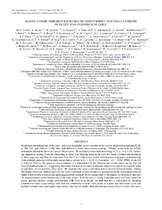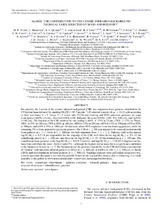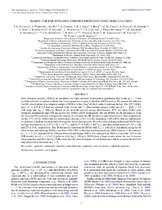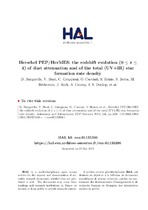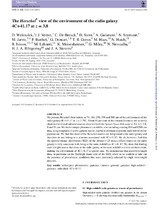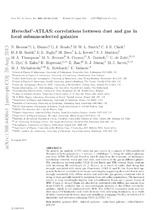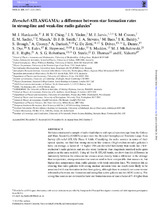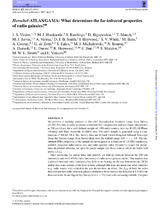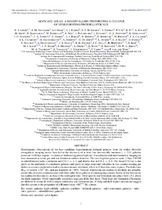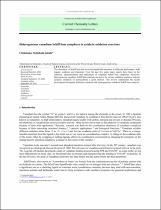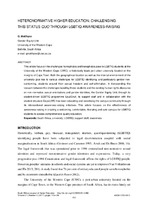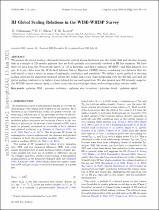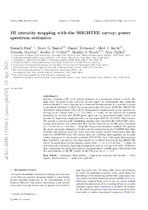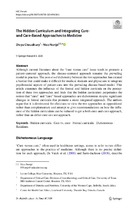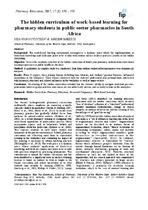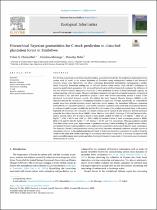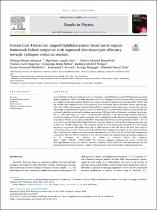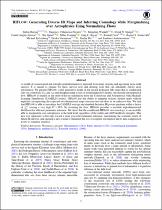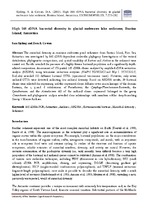Browsing by Title
Now showing items 3073-3092 of 7880
-
Hermes: Cosmic infrared background anisotropies and the clustering of dusty star-forming galaxies
(American Astronomical Society, 2013)Star formation is well traced by dust, which absorbs the UV/optical light produced by young stars in actively starforming regions and re-emits the energy in the far-infrared/ submillimeter (FIR/submm; e.g., Savage & ... -
HerMES: The contribution to the cosmic infrared background from galaxies selected by mass and redshift
(American Astronomical Society, 2013)The cosmic infrared background (CIB), discovered in Far Infrared Absolute Spectrophotometer (FIRAS) data from the Cosmic Background Explorer (COBE; Puget et al. 1996; Fixsen et al. 1998), originates from thermal ... -
HerMES: The far-infrared emission from dust-obscured galaxies
(American Astronomical Society, 2013)The far-infrared (far-IR) luminosities of luminous infrared galaxies (LIRGs) and ultra-LIRGs (ULIRGs) are dominated by reprocessed thermal dust emission, due to a combination of star formation and active galactic nucleus ... -
Herschel PEP/HerMES: the redshift evolution of dust attenuation and of the total (UV+IR) star formation rate density
(EDP Sciences, 2013)Using new homogeneous luminosity functions (LFs) in the far-ultraviolet (FUV) from VVDS and in the far-infrared (FIR) from Herschel/PEP and Herschel/HerMES, we studied the evolution of the dust attenuation with redshift. ... -
The Herschel* view of the environment of the radio galaxy 4C+41.17 at z = 3.8
(Oxford University Press, 2013)We present Herschel observations at 70, 160, 250, 350 and 500 μm of the environment of the radio galaxy 4C+41.17 at z = 3.792. About 65 per cent of the extracted sources are securely identified with mid-infrared sources ... -
Herschel*-ATLAS: correlations between dust and gas in local submm-selected galaxies
(2013)We present an analysis of CO molecular gas tracers in a sample of 500 μ m-selected Herschel -ATLAS galaxies at z < 0 . 05 ( cz < 14990 km s − 1 ). Using 22 − 500 μ m photom- etry from WISE , IRAS an ... -
Herschel-atlas/Gama: a difference between star formation rates in strong-line and weak-line radio galaxies
(OUP, 2013)We have constructed a sample of radio-loud objects with optical spectroscopy from the Galaxy and Mass Assembly (GAMA) project over the Herschel Astrophysical Terahertz Large Area Survey (Herschel-ATLAS) Phase 1 fields. ... -
Herschel-ATLAS/GAMA: What determines the far-infrared properties of radio galaxies?
(OUP, 2013)We perform a stacking analysis of Herschel Astrophysical Terahertz Large Area Survey (H-ATLAS) data in order to obtain isothermal dust temperatures and rest-frame luminosities at 250 µm (L250), for a well-defined sample ... -
Herschel-ATLAS: A binary HyLIRG pinpointing a cluster of starbursting protoellipticals
(American Astronomical Society, 2013)Panchromatic observations of the best candidate hyperluminous infrared galaxies from the widest Herschel extragalactic imaging survey have led to the discovery of at least four intrinsically luminous z = 2.41 galaxies across ... -
Heterogeneous vanadium Schiff base complexes in catalytic oxidation reactions
(Growing Science, 2023)The chemistry of Schiff base has received remarkable attention in different applications, both organic synthesis and industries. Over the past few years many reports have been on the synthesis, characterization and ... -
Heteronormative higher education: challenging this status quo through LGBTIQ awareness-raising
(Stellenbosch University, 2017)This article focus on the challenges homophobia and transphobia pose to LGBTIQ students at the University of the Western Cape (UWC), a historically black peri-urban university located on the margins of Cape Town. Both the ... -
Heydrichia cerasina sp. nov. (Sporolithales, Corallinophycidae, Rhodophyta) from the southernmost tip of Africa. Phycologia, 51(1): 11- 21
(International Phycological Society, 2012)A new species of Heydrichia (Sporolithales), H. cerasina sp. nov., is described, found only on pebbles in the low intertidal zone along a 10 km stretch of the South African south coast from Cape Agulhas to Struisbaai. The ... -
Hi global scaling relations in the wise-whisp survey
(Oxford University Press, 2021)We present the global scaling relations between the neutral atomic hydrogen gas, the stellar disk and the star forming disk in a sample of 228 nearby galaxies that are both spatially and spectrally resolved in HI line ... -
HI intensity mapping with the MIGHTEE survey: power spectrum estimates
(Monthly Notices of the Royal Astronomical Society, 2021)Intensity mapping (IM) with neutral hydrogen is a promising avenue to probe the large scale structure of the Universe. In this paper, we demonstrate that using the 64-dish MeerKAT radio telescope as a connected interferometer, ... -
The hidden curriculum and integrating cure- and care-based approaches to medicine
(Springer Nature, 2020)Although current literature about the “cure versus care” issue tends to promote a patient-centered approach, the disease-centered approach remains the prevailing model in practice. The perceived dichotomy between the two ... -
The hidden curriculum of work-based learning for pharmacy students in public sector pharmacies in South Africa
(International Pharmaceutical Federation, 2017)BACKGROUND: The work-based learning environment encompasses a dynamic space where the implementation of theoretical knowledge and skills may prove to be at odds with routine service delivery practices, known as the ... -
Hierarchical Bayesian geostatistics for C stock prediction in disturbed plantation forest in Zimbabwe
(Ecological Informatics, 2022)We develop and present a novel Bayesian hierarchical geostatistical model for the prediction of plantation forest carbon stock (C stock) in the eastern highlands of Zimbabwe using multispectral Landsat-8 and Sentinel-2 ... -
Hierarchiral 4-tetranitro copper(II)phthalocyanine based metal organic framework hybrid composite with improved electrocatalytic efficiency towards hydrogen evolution reaction
(Elsivier, 2019)A novel hybrid-hybrid nanocomposite based on 4-tetranitro copper(II)phthalocyanine (TNCuPc) grown on metal organic frameworks (MOF) as a noble metal-free catalyst for hydrogen evolution reaction (HER) was developed by a ... -
Hiflow: Generating diverse hi maps and inferring cosmology while marginalizing over astrophysics using normalizing flows
(IOP Publishing, 2022)A wealth of cosmological and astrophysical information is expected from many ongoing and upcoming large-scale surveys. It is crucial to prepare for these surveys now and develop tools that can efficiently extract ... -
High 16S rDNA bacterial diversity in glacial meltwater lake sediment, Bratina Island, Antarctica
(Springer Verlag, 2003)The microbial diversity in maritime meltwater pond sediments from Bratina Island, Ross Sea, Antarctica was investigated by 16S rDNA-dependent molecular phylogeny. Investigations of the vertical distribution, phylogenetic ...

